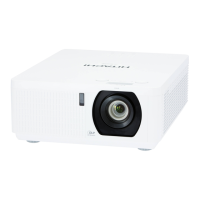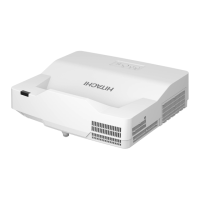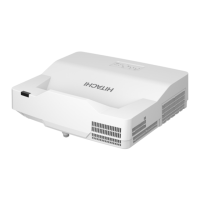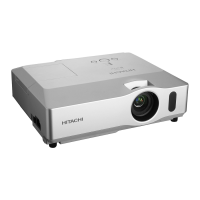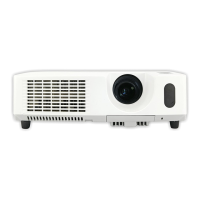Do you have a question about the Hitachi LP-WU6600 and is the answer not in the manual?
Lists the various signal formats supported by the projector for input.
Details the timing formats required for 3D signal compatibility.
Provides the physical dimensions of the projector.
Explains how to connect and control the projector via RS-232 serial interface.
Covers controlling the projector over a network via web browser.
Details commands for PJLink control protocol.
Provides copyright information and usage restrictions for the manual.
Outlines warranty conditions and after-service procedures.
Covers general safety, FCC compliance, and EU user information.
Details precautions regarding environment and light exposure.
Provides instructions to prevent electric shock hazards.
Covers electrical safety, overload, and handling procedures.
Advises on suitable environments and usage conditions.
Ensures safe installation and servicing practices.
Explains power cord safety and identifies safety marks.
Important notices to read before projector installation.
Provides safety guidelines for viewing 3D content.
Details laser warnings and product specifications.
Shows locations and explanations of product labels.
Describes various hazard and certification labels on the product.
Identifies laser aperture and explains interlock switch functions.
Lists toxic or hazardous substances contained in the product.
Identifies and describes components on the front of the projector.
Explains the meaning of the projector's LED indicators.
Identifies and describes components on the rear of the projector.
Details the functions of the buttons on the projector keypad.
Lists and describes all input/output ports on the projector.
Shows the bottom view and details mounting screw hole locations.
Identifies buttons and controls on the remote.
Details other functions and buttons on the remote control.
Explains signal range and how to install batteries.
Guides on installing and removing optional projector lenses.
Step-by-step instructions for removing the projector lens.
Explains throw distance calculation and installation modes.
Describes ceiling, rear, and mirror installation setups.
Details how to adjust the projector's lens shift.
Explains the range of vertical and horizontal lens movement.
Covers various ways to connect the projector to sources.
Provides instructions for powering the projector on and off.
Guides on how to select the correct input source.
Explains how to set a password for projector security.
Guides on selecting projection location and mode.
Details how to adjust angle, zoom, and focus for optimal projection.
Explains how to correct keystone distortion.
Details the 'Image' menu section and its sub-options.
Explains the different display modes available.
Guides on adjusting brightness and contrast for optimal picture.
Covers settings specific to computer input sources.
Details advanced image adjustment options.
Explains how to adjust colors using the Color Manager.
Describes DICOM SIM mode and user preset recall functions.
Details adjustments for computer input like position and phase.
Provides further details on advanced image settings.
Guides on adjusting video saturation and tint.
Explains controls for white balance, gain, and offset.
Details basic settings like source, projection, aspect ratio, keystone, zoom, and audio.
Covers advanced settings and 4 corner adjustment options.
Details audio sub-menu options: Volume, Mute, Internal Speaker.
Explains Language, Security Lock, Splash Logo, Captioning, Keypad Lock.
Covers 3D mode, sync, format, delay, and input settings.
Details Test Pattern and Image Shift adjustments.
Provides details on adjusting the four corners of the image.
Covers auto source, power management, and light mode settings.
Details status information and reset functions.
References to advanced settings from other menus.
Explains how to customize light settings.
Details specific light modes like Extreme Dimming and Custom Light.
Provides details on items found in the Status menu.
Details advanced 1 menu items like Menu Position and Low Power Mode.
Covers fan speed, light info, and remote ID settings.
Details network settings like DHCP, IP Address, and Subnet Mask.
Explains wired LAN connectivity and supported external devices.
Guides on setting up email alerts for projector events.
Details HDBaseT/IR control and advanced 2 menu specifics.
Provides instructions for cleaning the projector exterior and lens.
Addresses common problems related to powering the projector on/off.
Helps resolve problems with the remote control operation.
Covers issues like no picture, blank screen, or broken images.
Addresses problems with dim, bright, blurry, or washed-out pictures.
Helps resolve issues with pale colors, flashing, or incorrect colors.
Diagnoses problems related to cooling fan noise and LED errors.
Provides detailed specifications for model, resolution, display, light, and lens.
Lists input/output ports and details power requirements.
Specifies projector weight and available optional parts.
Guides on connecting and understanding the RS232 interface.
Details the RS232 protocol and command structure.
Explains the response and error codes for RS232 commands.
Describes the format of data replies for RS232 commands.
Covers network connection steps and communication ports.
Details settings for network command control.
Provides a comprehensive table of communication commands.
Explains how to query information using PJLink.
Lists the various signal formats supported by the projector for input.
Details the timing formats required for 3D signal compatibility.
Provides the physical dimensions of the projector.
Explains how to connect and control the projector via RS-232 serial interface.
Covers controlling the projector over a network via web browser.
Details commands for PJLink control protocol.
Provides copyright information and usage restrictions for the manual.
Outlines warranty conditions and after-service procedures.
Covers general safety, FCC compliance, and EU user information.
Details precautions regarding environment and light exposure.
Provides instructions to prevent electric shock hazards.
Covers electrical safety, overload, and handling procedures.
Advises on suitable environments and usage conditions.
Ensures safe installation and servicing practices.
Explains power cord safety and identifies safety marks.
Important notices to read before projector installation.
Provides safety guidelines for viewing 3D content.
Details laser warnings and product specifications.
Shows locations and explanations of product labels.
Describes various hazard and certification labels on the product.
Identifies laser aperture and explains interlock switch functions.
Lists toxic or hazardous substances contained in the product.
Identifies and describes components on the front of the projector.
Explains the meaning of the projector's LED indicators.
Identifies and describes components on the rear of the projector.
Details the functions of the buttons on the projector keypad.
Lists and describes all input/output ports on the projector.
Shows the bottom view and details mounting screw hole locations.
Identifies buttons and controls on the remote.
Details other functions and buttons on the remote control.
Explains signal range and how to install batteries.
Guides on installing and removing optional projector lenses.
Step-by-step instructions for removing the projector lens.
Explains throw distance calculation and installation modes.
Describes ceiling, rear, and mirror installation setups.
Details how to adjust the projector's lens shift.
Explains the range of vertical and horizontal lens movement.
Covers various ways to connect the projector to sources.
Provides instructions for powering the projector on and off.
Guides on how to select the correct input source.
Explains how to set a password for projector security.
Guides on selecting projection location and mode.
Details how to adjust angle, zoom, and focus for optimal projection.
Explains how to correct keystone distortion.
Details the 'Image' menu section and its sub-options.
Explains the different display modes available.
Guides on adjusting brightness and contrast for optimal picture.
Covers settings specific to computer input sources.
Details advanced image adjustment options.
Explains how to adjust colors using the Color Manager.
Describes DICOM SIM mode and user preset recall functions.
Details adjustments for computer input like position and phase.
Provides further details on advanced image settings.
Guides on adjusting video saturation and tint.
Explains controls for white balance, gain, and offset.
Details basic settings like source, projection, aspect ratio, keystone, zoom, and audio.
Covers advanced settings and 4 corner adjustment options.
Details audio sub-menu options: Volume, Mute, Internal Speaker.
Explains Language, Security Lock, Splash Logo, Captioning, Keypad Lock.
Covers 3D mode, sync, format, delay, and input settings.
Details Test Pattern and Image Shift adjustments.
Provides details on adjusting the four corners of the image.
Covers auto source, power management, and light mode settings.
Details status information and reset functions.
References to advanced settings from other menus.
Explains how to customize light settings.
Details specific light modes like Extreme Dimming and Custom Light.
Provides details on items found in the Status menu.
Details advanced 1 menu items like Menu Position and Low Power Mode.
Covers fan speed, light info, and remote ID settings.
Details network settings like DHCP, IP Address, and Subnet Mask.
Explains wired LAN connectivity and supported external devices.
Guides on setting up email alerts for projector events.
Details HDBaseT/IR control and advanced 2 menu specifics.
Provides instructions for cleaning the projector exterior and lens.
Addresses common problems related to powering the projector on/off.
Helps resolve problems with the remote control operation.
Covers issues like no picture, blank screen, or broken images.
Addresses problems with dim, bright, blurry, or washed-out pictures.
Helps resolve issues with pale colors, flashing, or incorrect colors.
Diagnoses problems related to cooling fan noise and LED errors.
Provides detailed specifications for model, resolution, display, light, and lens.
Lists input/output ports and details power requirements.
Specifies projector weight and available optional parts.
Guides on connecting and understanding the RS232 interface.
Details the RS232 protocol and command structure.
Explains the response and error codes for RS232 commands.
Describes the format of data replies for RS232 commands.
Covers network connection steps and communication ports.
Details settings for network command control.
Provides a comprehensive table of communication commands.
Explains how to query information using PJLink.
| Native aspect ratio | 16:10 |
|---|---|
| Projection distance | - m |
| Projection technology | DLP |
| Contrast ratio (typical) | 20000:1 |
| Screen size compatibility | - \ |
| Projector native resolution | WUXGA (1920x1200) |
| Keystone correction, vertical | -30 - 30 ° |
| Keystone correction, horizontal | -25 - 25 ° |
| Projector brightness (economic mode) | 4670 ANSI lumens |
| Lamps quantity | 1 lamp(s) |
| Service life of light source | - h |
| Focal length range | - mm |
| 3D | No |
| Full HD | Yes |
| Analog signal format system | - |
| Composite video in | 0 |
| HDMI connector type | Full-size |
| Serial interface type | RS-232C |
| USB 2.0 ports quantity | 1 |
| Placement | Desktop |
| Product type | Large venue projector |
| Product color | White |
| Market positioning | Presentation |
| Noise level | 35 dB |
| Noise level (economic mode) | 33 dB |
| RMS rated power | 12 W |
| Power source | AC |
| AC input voltage | 100 - 240 V |
| AC input frequency | 50 - 60 Hz |
| Power consumption (standby) | 0.5 W |
| Power consumption (typical) | 700 W |
| Remote control type | IR |
| Depth | 470 mm |
|---|---|
| Width | 521 mm |
| Height | 220 mm |
| Weight | 24500 g |
